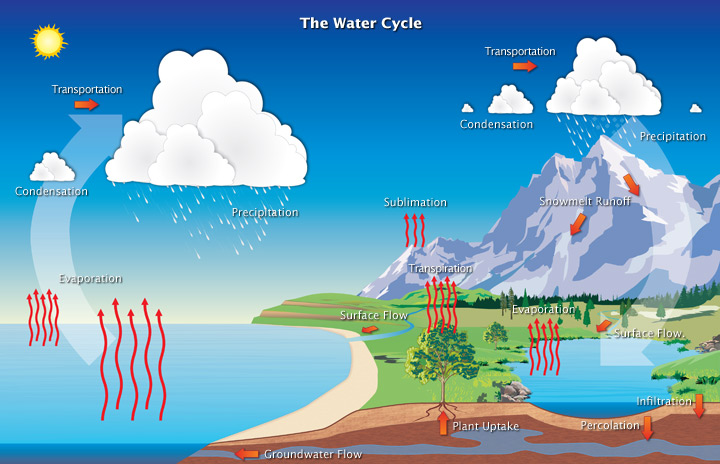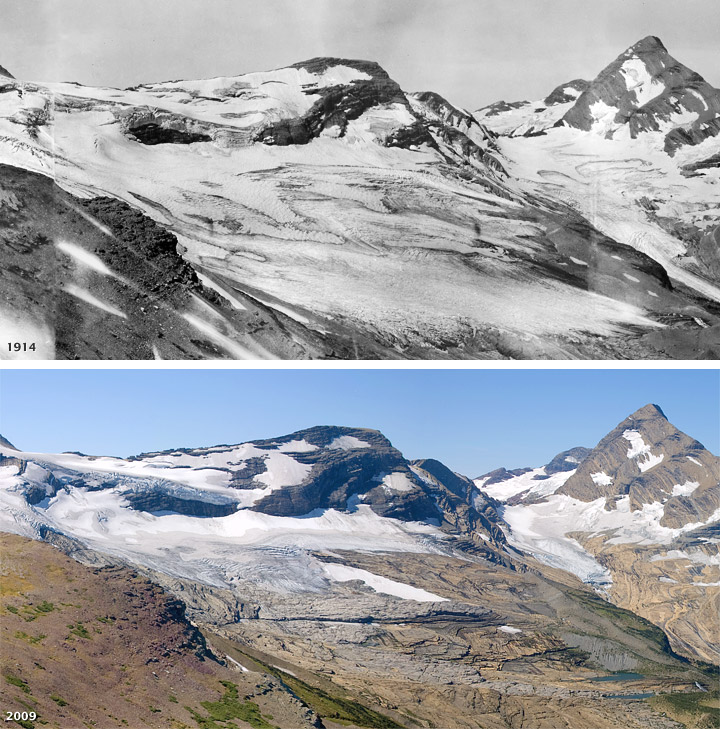what are the four forms that water takes when it returns to earth from the clouds
A Multi-Phased Journey
The water, or hydrologic, bike describes the pilgrimage of water as water molecules brand their way from the Earth's surface to the atmosphere and back again, in some cases to below the surface. This gigantic organisation, powered past energy from the Lord's day, is a continuous exchange of moisture between the oceans, the temper, and the land.

Earth's water continuously moves through the atmosphere, into and out of the oceans, over the land surface, and underground. (Image courtesy NOAA National Atmospheric condition Service Jetstream.)
Studies have revealed that evaporation—the process by which water changes from a liquid to a gas—from oceans, seas, and other bodies of h2o (lakes, rivers, streams) provides most ninety% of the moisture in our atmosphere. Most of the remaining 10% found in the atmosphere is released by plants through transpiration. Plants take in h2o through their roots, then release it through small pores on the underside of their leaves. In add-on, a very pocket-size portion of water vapor enters the temper through sublimation, the procedure by which water changes directly from a solid (ice or snow) to a gas. The gradual shrinking of snowfall banks in cases when the temperature remains below freezing results from sublimation.
Together, evaporation, transpiration, and sublimation, plus volcanic emissions, business relationship for most all the water vapor in the atmosphere that isn't inserted through man activities. While evaporation from the oceans is the primary vehicle for driving the surface-to-temper portion of the hydrologic cycle, transpiration is besides significant. For example, a cornfield 1 acre in size can transpire as much equally 4,000 gallons of h2o every day.
Later on the water enters the lower atmosphere, rising air currents carry it upwardly, often high into the atmosphere, where the air is cooler. In the cool air, water vapor is more probable to condense from a gas to a liquid to form cloud aerosol. Deject droplets tin can grow and produce precipitation (including pelting, snow, sleet, freezing pelting, and hail), which is the chief mechanism for transporting water from the temper back to the Earth'southward surface.
When precipitation falls over the land surface, information technology follows diverse routes in its subsequent paths. Some of information technology evaporates, returning to the atmosphere; some seeps into the ground as soil moisture or groundwater; and some runs off into rivers and streams. Almost all of the water somewhen flows into the oceans or other bodies of water, where the cycle continues. At unlike stages of the cycle, some of the water is intercepted by humans or other life forms for drinking, washing, irrigating, and a large diverseness of other uses.
Groundwater is found in two broadly defined layers of the soil, the "zone of aeration," where gaps in the soil are filled with both air and water, and, farther downwards, the "zone of saturation," where the gaps are completely filled with water. The boundary between these two zones is known as the water table, which rises or falls as the amount of groundwater changes.
The amount of water in the atmosphere at any moment in fourth dimension is only 12,900 cubic kilometers, a minute fraction of World's total water supply: if it were to completely rain out, atmospheric moisture would cover the Earth'southward surface to a depth of just 2.v centimeters. Notwithstanding, far more water—in fact, some 495,000 cubic kilometers of it—are cycled through the atmosphere every year. It is as if the entire amount of water in the air were removed and replenished nearly 40 times a twelvemonth.

This map shows the distribution of water vapor throughout the depth of the atmosphere during August 2010. Even the wettest regions would form a layer of h2o only sixty millimeters deep if it were condensed at the surface. (NASA epitome past Robert Simmon, using Arrogance & AMSU information.)
Water continually evaporates, condenses, and precipitates, and on a global basis, evaporation approximately equals precipitation. Considering of this equality, the total amount of water vapor in the atmosphere remains approximately the same over fourth dimension. However, over the continents, precipitation routinely exceeds evaporation, and conversely, over the oceans, evaporation exceeds precipitation.
In the case of the oceans, the continual excess of evaporation versus precipitation would somewhen leave the oceans empty if they were non beingness replenished past additional means. Non only are they being replenished, largely through runoff from the country areas, but over the past 100 years, they have been over-replenished: sea level around the globe has risen approximately 17 centimeters over the course of the twentieth century.

Sea level has risen both because of warming of the oceans, causing water to aggrandize and increase in volume, and because more water has been entering the body of water than the corporeality leaving information technology through evaporation or other means. A primary cause for increased mass of h2o entering the ocean is the calving or melting of land ice (ice sheets and glaciers). Bounding main ice is already in the ocean, so increases or decreases in the annual amount of sea water ice do non significantly impact bounding main level.

Blackfoot (left) and Jackson (right) glaciers, both in the mountains of Glacier National Park, were joined along their margins in 1914, but take since retreated into split tall cirques. The melting of glacial water ice is a major correspondent to bounding main level rise. [Photographs past Eastward. B. Stebinger, Glacier National Park athenaeum (1911), and Lisa McKeon, USGS (2009).]
Throughout the hydrologic cycle, at that place are many paths that a water molecule might follow. H2o at the bottom of Lake Superior may eventually rise into the atmosphere and fall equally pelting in Massachusetts. Runoff from the Massachusetts rain may drain into the Atlantic Body of water and circulate northeastward toward Republic of iceland, destined to become function of a floe of body of water ice, or, after evaporation to the atmosphere and atmospheric precipitation as snow, part of a glacier.
Water molecules tin have an immense variety of routes and branching trails that pb them again and once again through the iii phases of ice, liquid water, and water vapor. For instance, the h2o molecules that once vicious 100 years ago as rain on your great- grandparents' farmhouse in Iowa might now exist falling as snow on your driveway in California.
Source: https://earthobservatory.nasa.gov/features/Water/page2.php